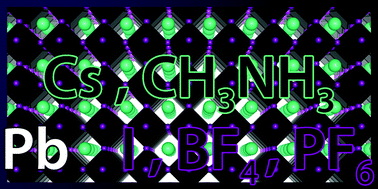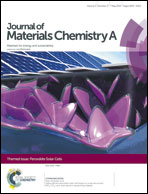Assessment of polyanion (BF4− and PF6−) substitutions in hybrid halide perovskites
Abstract
Halide perovskites have attracted attention for light-to-electricity conversion in solar cells due to their favorable optoelectronic properties. In particular, the replacement of the A cation by an isovalent molecule has proven highly successful. We explore the substitution of the X anion, producing polyanion perovskites based on hexafluorophosphate and tetrafluoroborate. Starting from CsPbI3, the effect of partial and complete substitution is investigated using relativistic electronic structure calculations. BF4− results in a larger perturbation to the electronic structure than PF6−; however, both localise the band edge states, and the end member compounds are predicted to be wide band gap dielectrics.

- This article is part of the themed collection: Perovskite Solar Cells

 Please wait while we load your content...
Please wait while we load your content...